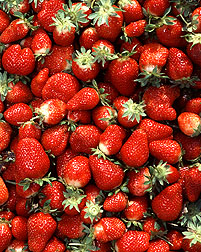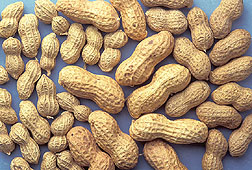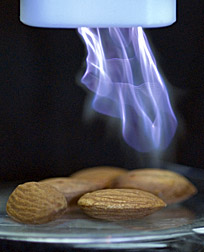| October 2008 |
Sizing Up Teen SnackingThe effect of snacking on teenagers' dietary intakes of recommended nutrients and MyPyramid food groups has been examined, and the findings are both positive and negative. After analyzing the eating habits of more than 4,000 teenagers surveyed nationwide, Agricultural Research Service (ARS) scientists found that 90 percent reported eating one or more snacks in a day. Overall, snacking was found to enhance the intake of some MyPyramid food groups, but it also contributed to the intake of excess discretionary calories as added sugars and fats. Among the highest snackers—those who consumed four or more snacks in a day—both boys and girls ate more than twice as much fruit as their non-snacking peers. Even so, almost three-quarters of those eating relatively high amounts of fruit failed to meet their MyPyramid recommendation to consume 1.5 to 2.5 cups of fruit daily, depending on age, gender and activity level. Scientific contact: Rhonda S. Sebastian, (301) 504-0343, ARS Beltsville Human Nutrition Research Center, Beltsville, Md. |
|
| Calcium Alone Does Not Reduce Hip Fracture RiskPeople, especially the elderly, may reach for calcium supplements in hopes of protecting themselves against bone fractures in case of a fall. But a recent analysis of several studies found no reduction in risk of hip fracture with calcium supplementation. Among the studies that met the researchers' screening criteria, seven included a total of 170,991 women with nearly 3,000 hip fractures. Five of the studies included a total of 68,606 men with 214 hip fractures. Pooled results from those studies suggest that calcium intake is not appreciably associated with hip fracture risk in women or men. That means that the researchers did not find that a higher calcium intake reduced the incidence of hip fractures. The analysis was supported in part by the Agricultural Research Service (ARS). Scientific contact: Bess Dawson-Hughes, (617) 556-3066, Jean Mayer USDA Human Nutrition Research Center on Aging, Boston, Mass. |
Potassium and Potato PreparationThe preparation of a potato can have a big impact on its mineral content, Agricultural Research Service (ARS) scientists have reported. Cubing potatoes can reduce boiling time, but it also reduces mineral content by as much as 75 percent. This could be a good cooking strategy for potato fans hoping to reduce potassium intake, such as dialysis patients. But individuals who want to get the highest nutritional bang for their buck would be better off boiling their potatoes whole. The effects of leaching the potatoes—letting them soak in water overnight—were also examined. Results showed that leaching had no significant impact on potassium reduction, in contrast with conventional wisdom. Scientific contact: Shelley Jansky, (608) 262-8324, ARS Vegetable Crops Research Unit, Madison, Wis. |
|
More Strawberries, More Antioxidant AbsorptionAgricultural Research Service (ARS) scientists have assessed the human body's capacity for absorbing certain antioxidant compounds in strawberries, and have found that the absorption of one key beneficial plant chemical was not "maxed out" as volunteers ate more of this popular fruit. Foods high in antioxidants may be excellent sources of healthful compounds, and researchers are striving to learn more about their ability to be absorbed and utilized within the human body. The study showed that the human body is capable of assimilating more anthocyanin pigments as intakes increase. Scientific contact: Janet Dura-Novotny, (301) 504-8263, Food Components and Health Laboratory, ARS Beltsville Human Nutrition Research Center, Beltsville, Md. |
Protecting Romaine Lettuce From PathogensKnowing the preferences of foodborne pathogens such as Escherichia coli O157:H7 is essential to a successful counterattack on these microbes. That's why Agricultural Research Service (ARS) microbiologist Maria T. Brandl and University of California-Berkeley colleague Ronald G. Amundson are scrutinizing the little-understood ability of E. coli O157:H7 and Salmonella enterica to contaminate romaine lettuce. In experiments, the scientists exposed romaine lettuce leaves to E. coli O157:H7. They found that, after 24 hours, populations of the microbe were 10 times higher on young leaves than on middle ones. One explanation: The young leaves are a richer nutritional "hunting ground" for E. coli. They exude about three times more nitrogen and about 1.5 times more carbon than do the middle leaves. Scientific contact: Maria Brandl, (510) 559-5885, Produce Safety and Microbiology Research Unit, ARS Western Regional Research Center, Albany, Calif. |
|
New Research on Peanut ComponentsFat-free peanut flour, whole peanuts and peanut oil all may have cardio-protective properties, results from a new animal study by Agricultural Research Service (ARS) scientists suggest. For the study, male hamsters were randomly divided into four groups. Each group of nearly 20 hamsters was fed one of four different diets, all of which were high-fat and high-cholesterol. For three of the four test diets, equivalent amounts of food components were substituted with fat-free peanut flour, peanut oil or peanuts without skins. The fourth diet contained no peanut product. Compared to hamsters in the group that ate no peanut products, those in each of the three groups that did eat peanut products were found to have significantly lower total cholesterol and LDL "bad" cholesterol. Also positive, HDL "good" cholesterol levels held steady. Scientific contact: Timothy H. Sanders, (919) 515-6312, ARS Market Quality and Handling Research Unit, Raleigh, N.C. |
Meat Safety: It All Works Out in the WashAgricultural Research Service (ARS) scientists have developed a hide-washing tool that has significantly improved the safety of U.S. beef while saving the beef industry millions of dollars each year. An estimated 50 percent of U.S. feedlot-raised beef cattle undergo the washing treatment, which has reduced the national incidence of pathogenic Escherichia coli in ground beef samples by about 43 percent. Scientific contact: Terrance M. Arthur, (402) 762-4227, Meat Safety and Quality Research Unit, ARS Roman L. Hruska U.S. Meat Animal Research Center, Clay Center, Neb. |
|
| Pathogen Genes Targeted in Studies to Protect Salad VeggiesAn Agricultural Research Service (ARS) researcher is working to pinpoint genes responsible for the widely varying ability of eight different Listeria strains to successfully colonize the hair-thin strands, called root hairs, of alfalfa sprouts. She's also interested in studying, and disabling, genes that help some Listeria colonies resist being washed off leaves of produce such as cabbage by water. Scientific contact: Lisa A. Gorski, (510) 559-6046, Produce Safety and Microbiology Research Unit, ARS Western Regional Research Center, Albany, Calif. |
Food Safety Developments Are in the AirAn experimental treatment from Agricultural Research Service (ARS) scientists that is based on cold plasma could one day help protect some fresh produce from potentially dangerous microbes such as Salmonella, Listeria and Escherichia coli O157:H7. Cold plasma is generated when some form of concentrated energy—in this case, electricity—is introduced into a gas until free electrons are torn from the gas' atoms. This plasma-forming process is related to the technology used to create plasma for computer chips. But in addition to increasing conductivity, the process of turning gas into plasma has an antimicrobial effect. The ARS researchers aren't the first to harness this technology for food safety purposes, but their method of production has the potential for increased efficiency and lower costs when applied at a larger scale. Scientific contact: Brendan A. Niemira, (215) 836-3784, Microbial Food Safety Research Unit, ARS Eastern Regional Research Center, Wyndmoor, Penn. |
|
| ARS Releases Gulfcrimson Peach to NurseriesA new peach variety that requires less winter chilling will give growers in the southeastern lower coastal plain an edge—and consumers a more reliable supply—of early summertime peaches. The new variety, called Gulfcrimson, was developed by the Agricultural Research Service (ARS) in cooperation with the University of Georgia and the University of Florida. Gulfcrimson only requires 400 hours of chilling to flower and set fruit. By comparison, a commonly grown variety called June Gold requires 650 hours of chilling. However, in years of insufficient winter chilling, June Gold can't reliably set fruit, resulting in reduced crops for growers. Scientific contact: Thomas G. Beckman, (478) 956-6436, ARS Southeast Fruit and Tree Nut Research Lab, Byron, Ga. |











